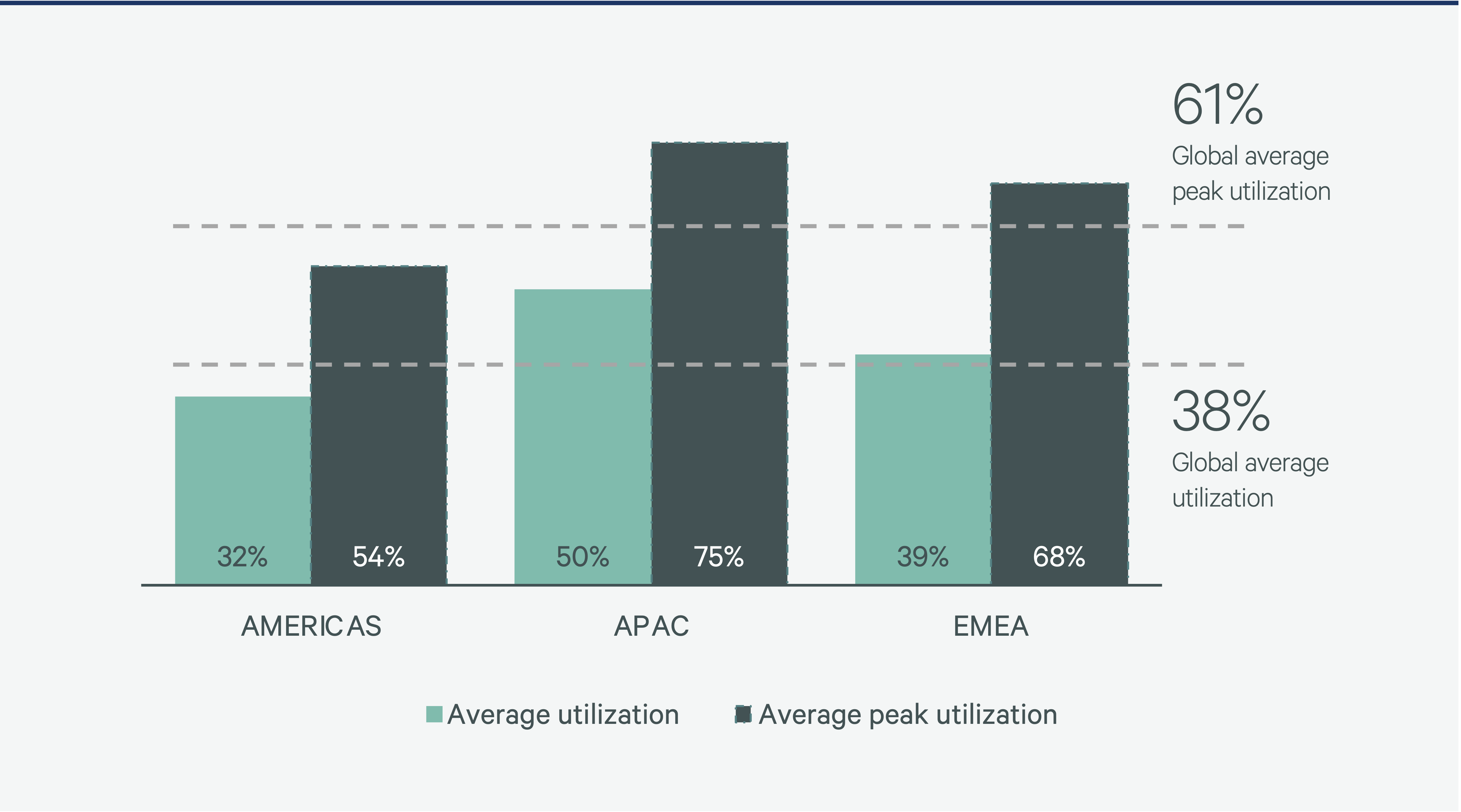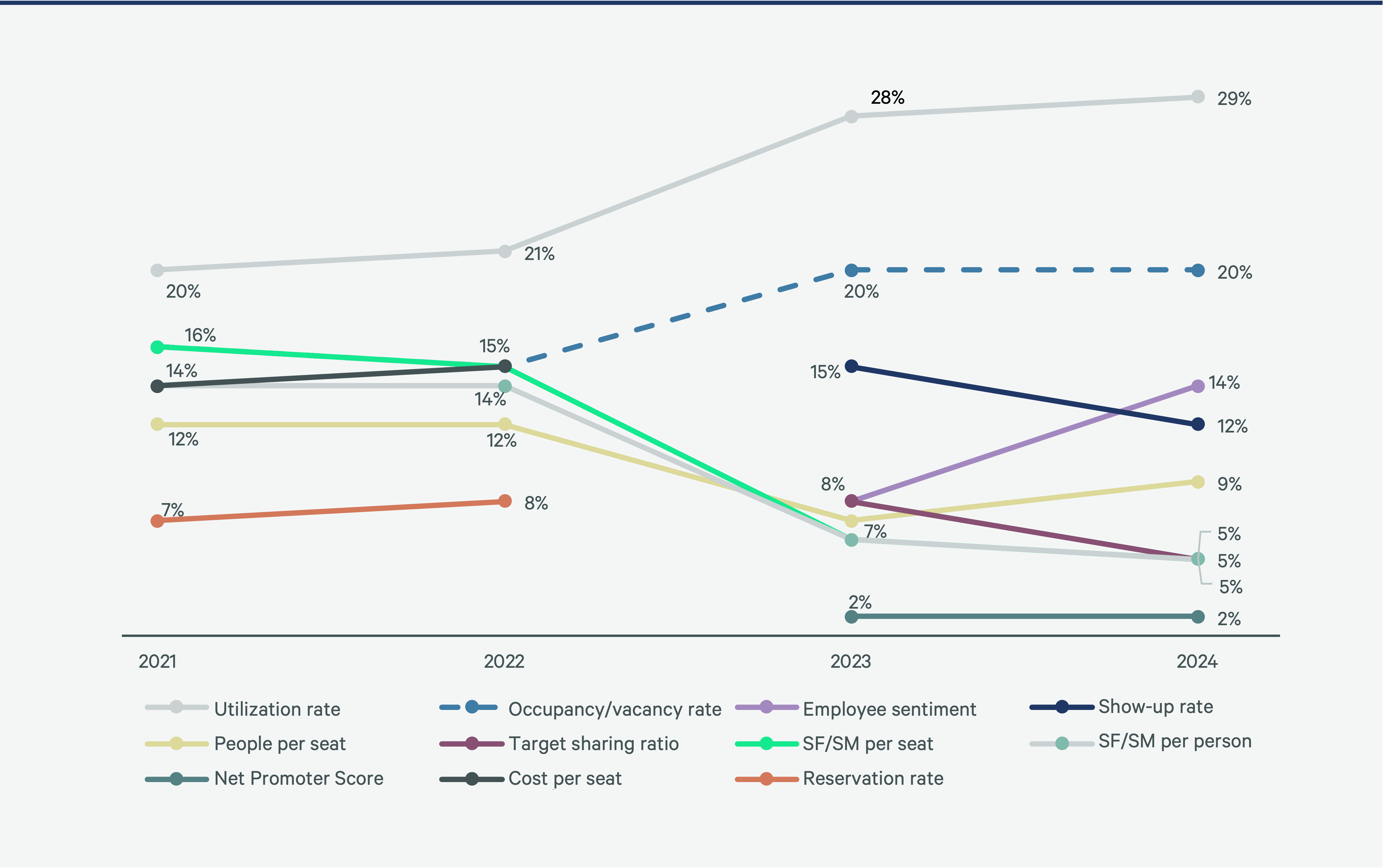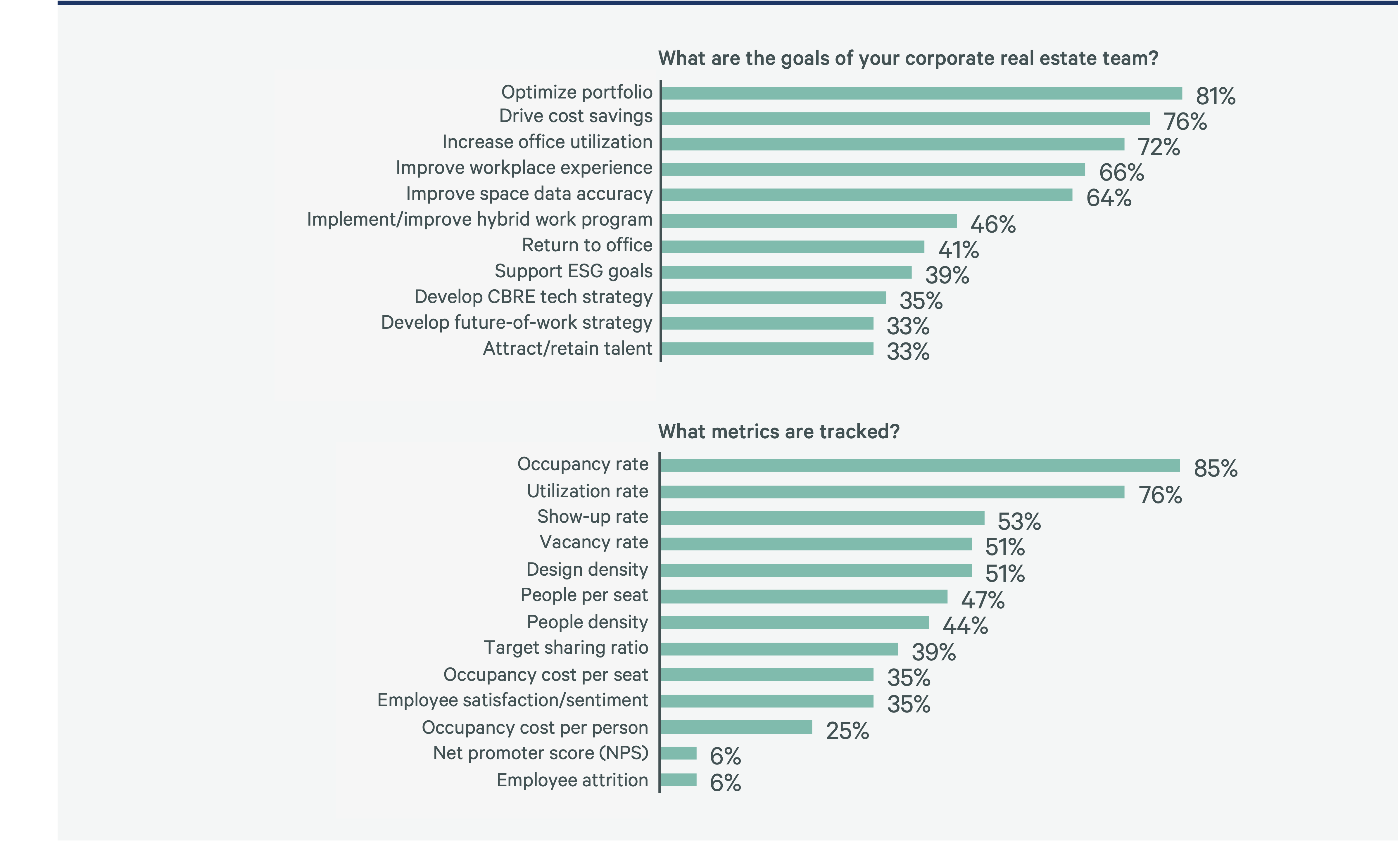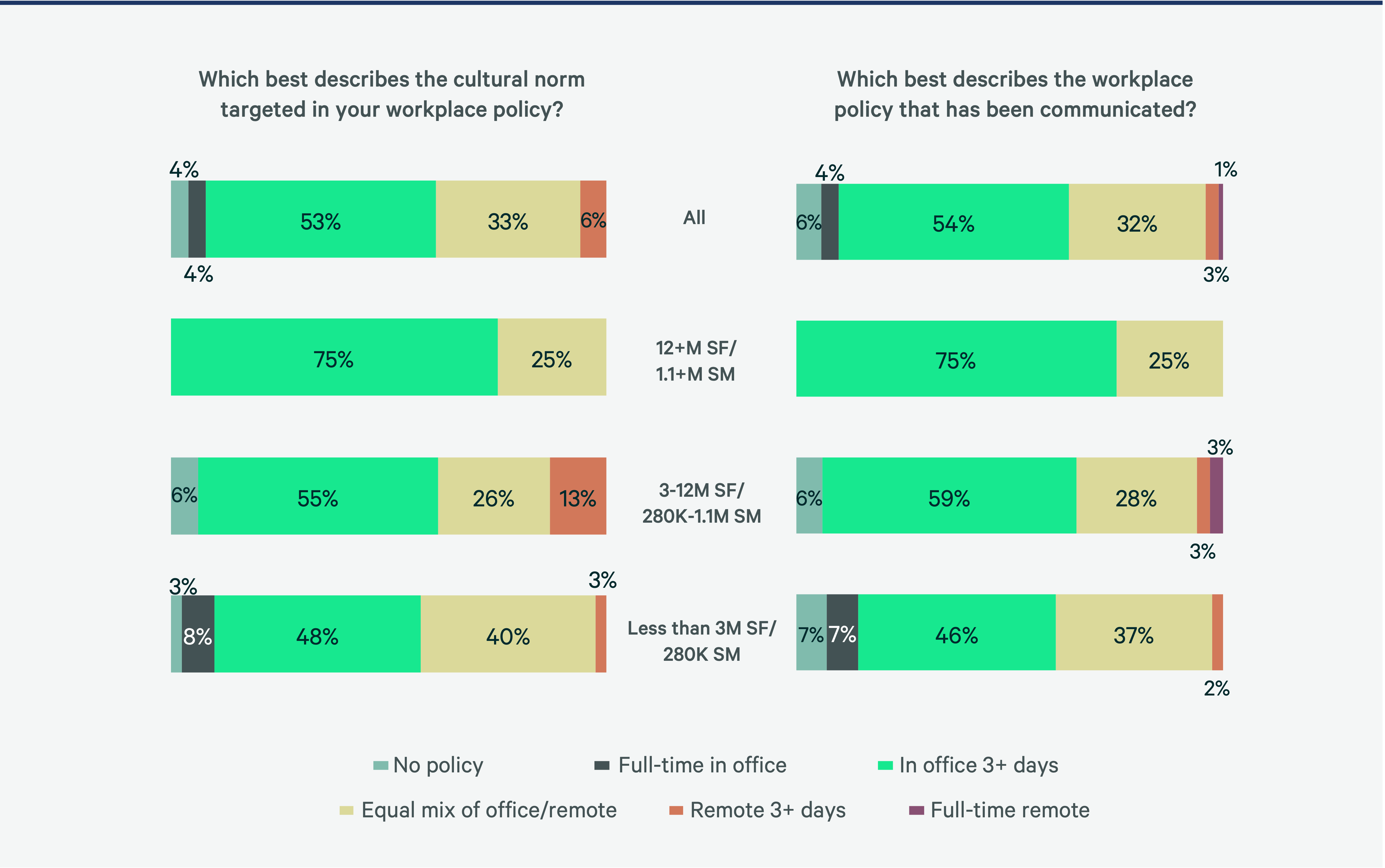Adaptive Spaces
Companies Now Prefer Metrics That Measure Effectiveness, Rather Than Efficiency
The first in our 2024-2025 CBRE Global Workplace & Occupancy Insights series offers insights on redefining metrics to gauge the success of workplace strategies.
October 29, 2024 6 Minute Read

Subscribe for More of This Content
Effective Metrics
Organizations are increasingly focusing on workplace experience as a main component of real estate success and use effectiveness, rather than efficiency, as the preferred measure of that success. The pandemic created a power struggle between employers and employees, demonstrating that the optimal approach must meet the needs of both parties. In 2024, prioritizing the creation of effective, mutually beneficial workplaces is more important than ever.
A majority of CBRE clients (79%) target utilization rates of 65% or more, but actual utilization rates lag at 38% and have increased by only three percentage points from last year. This data indicates a reluctance among employees to return to a five-day, in-office work week, which likely comes as little surprise. Additionally, unlike the first two years of the pandemic when clients were not making major portfolio changes, in 2023 and 2024 our clients have shifted toward specific hybrid working models and are optimizing their portfolios to accommodate this change in demand.
Occupancy Strategy Terms
Occupancy Rate: The total number of people that are allocated to a seat or neighborhood at a location divided by design capacity.
Office Attendance: The total number of employees who visit the office in a given time period.
Office Show-up Rate: A method of understanding the demand for space based on employee attendance patterns. Calculated by dividing the office attendance (OA) by the total headcount of the office.
Office Utilization Rate: A method of comparing space demand and supply to determine if space is being used effectively. Calculated by dividing the office attendance by the capacity of the office.
Office attendance data helps organizations understand their demand for space, while space utilization data measures how effectively the space supports that demand.
For the second year in a row, global occupancy rates have consistently exceeded 100%, signifying the shift from the historical trend of always having more seats than employees. In fact, portfolio optimization and hybrid program adoption have resulted in a 15% reduction in the average square footage per individual and a 21% reduction in individual (“Me”) space since 2021. This scenario of more people than seats, less space per person and a decline in individual space has led to a staggering 94% increase in target sharing ratios at or above 1.5:1 since 2021.
Undoubtedly, portfolios have evolved, yet imbalances between supply and demand continue to exist. Regular measurement of workplace efficacy metrics can help identify successful workplace aspects and develop strategies to enhance performance.
Access our Office Occupancy Management Benchmarks Dashboard for more benchmarking data.
Figure 1: Average Office Utilization and Average Peak Office Utilization Rates

According to CBRE’s 2024 Americas Office Occupier Sentiment Survey, 73% of occupiers believe their workplace is effective, yet only 46% actively measure effectiveness. The survey revealed effectiveness is commonly measured through space utilization, employee engagement scores and retention/attrition rates. Companies solely using space utilization are less likely to report an effective workplace compared with those also relying on interpersonal connection data like employee sentiment or retention rates.
This year, the metrics our clients deem important have shifted toward effectiveness measurements such as utilization and employee sentiment or satisfaction. These indicators have surged in popularity, while traditional ones like density or target sharing ratio have declined. When asked to rank the metrics that hold the most significance for them, our clients cited utilization rate, occupancy rate and employee satisfaction or sentiment at the top of the list. This response is a clear indication of the growing influence and recognition of these effective measures.
In particular, the emphasis on employee satisfaction or sentiment has grown significantly. This metric exhibited the largest jump in importance this year to 14%, compared with 8% in 2023. This surge underscores the increased focus on employee morale and happiness as critical determinants of overall business success. On the other hand, traditional metrics like Design Density and People Density have not seen the same growth. In fact, these metrics have been on a declining trend for the past four years, from 16% to 5% (-69%) and 14% to 5% (-65%), respectively.
Figure 2: Occupancy Metrics that Matter Most 2021-2024

How can organizations prove workplace effectiveness and policy success? Achieving Corporate Real Estate (CRE) goals is gauged using metric measurements, which need to align with company goals. This alignment allows for accurate tracking of progress and ensures efforts are concentrated in achieving desired outcomes or even point to next steps.
Top CRE goals often include aspects such as optimization, cost savings and office utilization. Further, these goals concurrently align with the metrics that our clients are tracking.
Figure 3: Goals of CRE Teams & Metrics that are Tracked

A critical component in establishing the efficacy of workplace operations and of policy implementation is ensuring that the set objectives are in harmony with the disseminated policies. A staggering 96% of organizations have a definitive workplace policy in place. They note minimal variation between the target behaviors and those being articulated as part of their workplace policy. This strong correlation sets the stage for the successful implementation and realization of these policies. Aligning targets with communicated policies can contribute greatly toward goal achievement but also enhance trust, transparency, consistency and productivity in the workplace.
Figure 4: The difference between targeted behavior and communicated requirements

Key Takeaway
More and more organizations are prioritizing workplace experience as a key factor in real estate success, highlighting that effectiveness, rather than efficiency, is a crucial success metric. Workplace success can be accomplished using effective metrics, which are key performance indicators that help monitor and analyze the performance and productivity of the workplace.
Methodology
The 2024-2025 Global Workplace & Occupancy Insights summarize four years of office benchmarking and client sentiment surveys to observe how CBRE clients have adapted their office environments over the past four years. The study examines global data from select CBRE clients representing 375 million sq. ft./35 million sq. m. and delivers insights by portfolio size, industry/sector and region/geography.
About This Series
Hybrid work has sparked a balancing act between employers and employees, with the goal of creating effective workplaces that satisfy both parties’ needs. The 2024-2025 CBRE Global Workplace & Occupancy Insights emphasize essential aspects: effective versus efficient metrics, strategic hybrid programs, the role of physical spaces and the transformative power of technology and AI. Taken together, these reveal a comprehensive approach to creating productive and satisfying work environments. This five-part series explores trends across major office occupiers, providing valuable insights for organizations seeking to align their workplaces with business needs and cultural objectives.
This year, insights will be presented in five parts, followed by four articles that provide perspective.
In Part 2 and Part 3, we explore how effective workplaces require strategic hybrid programs, which have increased in adoption by 30% over the past four years. In 2024, 92% of surveyed clients use a hybrid work model. We examine characteristics of the most popular hybrid policies: leadership expectations versus employee behaviors, mandates versus incentives and policy impact on talent retention.
Part 4 demonstrates how the physical aspects of the workplace are critical and complementary to effectiveness. Over the past four years, portfolio optimization has steadily remained the top CRE goal and directly contributed to the consistent migration of Individual “Me” space to Collaborative “We” space from 2021 through 2023. To learn whether individual workspace is still shrinking in favor of collaboration space, we explore space composition trends, investigate current and forecast workplace design concepts, discuss how emerging personas are shaping the workplace and reveal a shift in portfolio rightsizing.
Part 5 showcases the practical application of powerful and influential technology. We discuss AI integration trends, tech’s increasing value to hybrid work and how compelling technology is utilized to optimize portfolios and improve workplace experiences. Increasingly, data points to effective technology being vital for productive workplaces.

Office Occupancy Management Benchmarks
Leverage our Tableau dashboard to enhance occupancy decision-making. Customize filters to focus on your specific sector and region.
Contacts
Susan Wasmund
Executive Managing Director, Americas Consulting | Global Occupancy Management

Jess Ultreras
Global Data Program Lead, Americas Consulting | Global Occupancy Management

Related Insights
-
Article | Evolving Workforces
Effective Hybrid Programs: Policies & Common Characteristics
January 22, 2025

Hybrid work models have become the dominant workplace strategy. Implementing and measuring these models has evolved.
Related Services
Leverage occupancy data to empower, anticipate and unlock opportunities within your portfolio.
- Plan, Lease & Occupy
Workplace Consulting
Build resilience, attract and retain talent, and foster connection and collaboration in your workplace.
- Transform Business Outcomes
Consulting
Gain comprehensive guidance on insightful, executable real estate strategies for both investors and occupiers.
- Plan, Lease & Occupy
Organizational Change & Transformation
Enabling organizations to achieve outcomes, improve performance and create change-ready cultures.



